Welcome to Ceramic Review
Ceramic Review is the magazine for contemporary and historical ceramics, ceramic art and pottery.
Ceramic Review Issue 328
July/August 2024
Ceramic Review is the magazine for contemporary and historical ceramics, ceramic art and pottery.
July/August 2024
As a nation of tea drinkers, what better way to celebrate a cup that cheers than with an exhibition of teapots. Colin Martin visits Musée Ariana in Geneva to discover more at Gallivanting Teapots
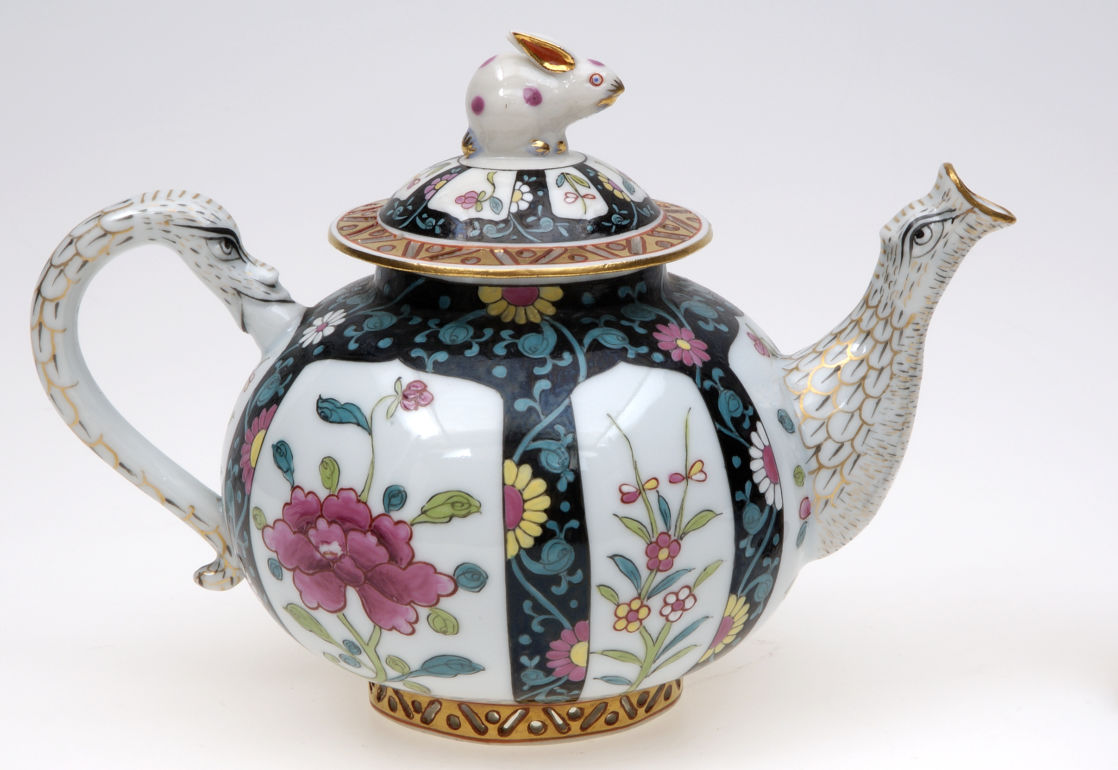
Teapot, Herend (Hungary), c.1870 Porcelain, polychrome enamel and gold decoration, width 14 cm, height 10.8 cm Photo: Angelo Lui
In times of crisis, such as the present coronavirus pandemic, drinking tea strengthens our resolve to ‘keep calm and carry on’. Now however, instead of sipping serenely from delicate teabowls in the Chinese tradition, we more often agitate teabags in earthenware mugs. Some leave teabags in while drinking, their paper tags fluttering in defiance of gentility, if not deadly viruses.
An intriguing exhibition at the Musée Ariana in Geneva, viewed before travelling across Europe was suspended, charts how the form, style and decoration of ceramic teapots has evolved since they were first used in China in the early 16th century. Tea drinking was unknown in Europe until the early 17th century, when Dutch East India Company merchants began importing tea leaves; followed by teapots, in the second half of the century. A selection of 74 teapots from different historic periods and countries, chosen from more than 330 in the museum’s collection, demonstrate how rapidly the ‘art’ of tea drinking spread across Europe.
ORIGINS AND INFLUENCES
Teapots have thrown or cast bodies and three added elements; lids, handles and spouts. Some also incorporate internal filters at the base of their spouts, to strain leaves when tea is poured. Chinese teapots exported to Europe were made using red stoneware (in Yixing) or porcelain (in Jingdezhen). Yixing teapots were spherical with domed lids, rounded handles, and straight, slanted spouts. They were relatively smaller than those used earlier in China, enabling Europeans to savour tea’s aroma (and more pragmatically, to use expensive leaves more sparingly).
The first porcelain teapots exported to Europe were in the blue and white style, using cobalt blue as underglaze decoration. The shape of one example (from the second half of the 17th century), with a four-lobed body and lid, high rectangular handle and curved spout is reminiscent of ancient Chinese wine jugs. In the 18th century the range of colours utilised in Chinese decorative designs was extremely rich, including Imari (copied from Japan), Famille verte and Famille rose styles.
Nature was an important source of inspiration in China. Manufacturers produced teapots in the forms of bamboo, tree trunks, flowers or vegetables; and animal-shaped teapots, including deer, roosters, hens and turtles. These forms often had symbolic meanings previously unknown in the West. A teapot resembling a bundle of bamboo stems, which bend without breaking (Jingdezhen, 1662–1722), copied in porcelain from a popular Yixing design, signifies uprightness and piety, in addition to robustness and flexibility. Another in the form of a seated deer (Jingdezhen, c.1780), decorated with Famille verte enamels, symbolises longevity and regeneration, as deer regrow their antlers after they are shed each year.
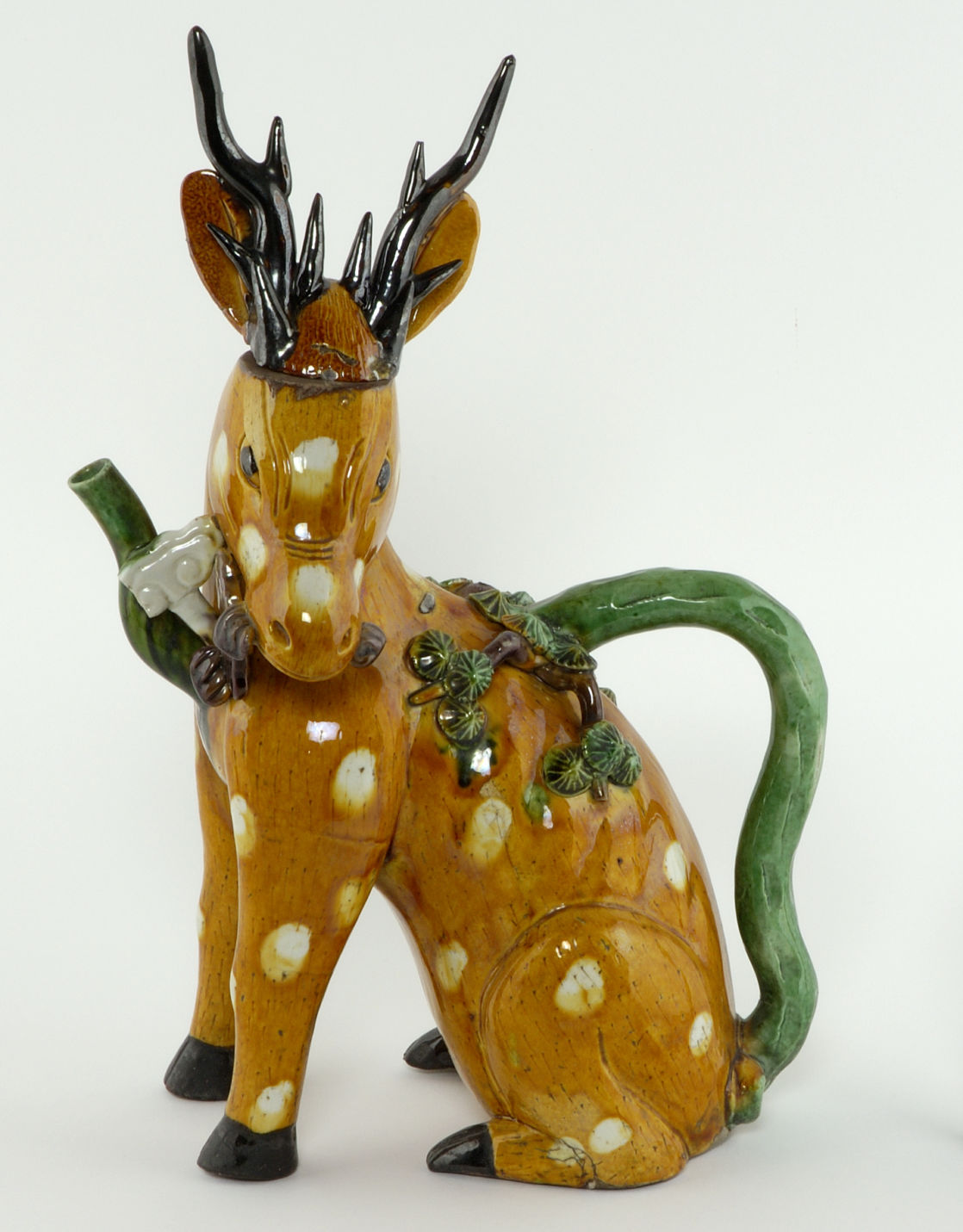
Teapot, Jingdezhen (China), c.1780 Porcelain, Famille verte enamel decoration, L. 18 cm. H. 27 cm Photo: Angelo Lui
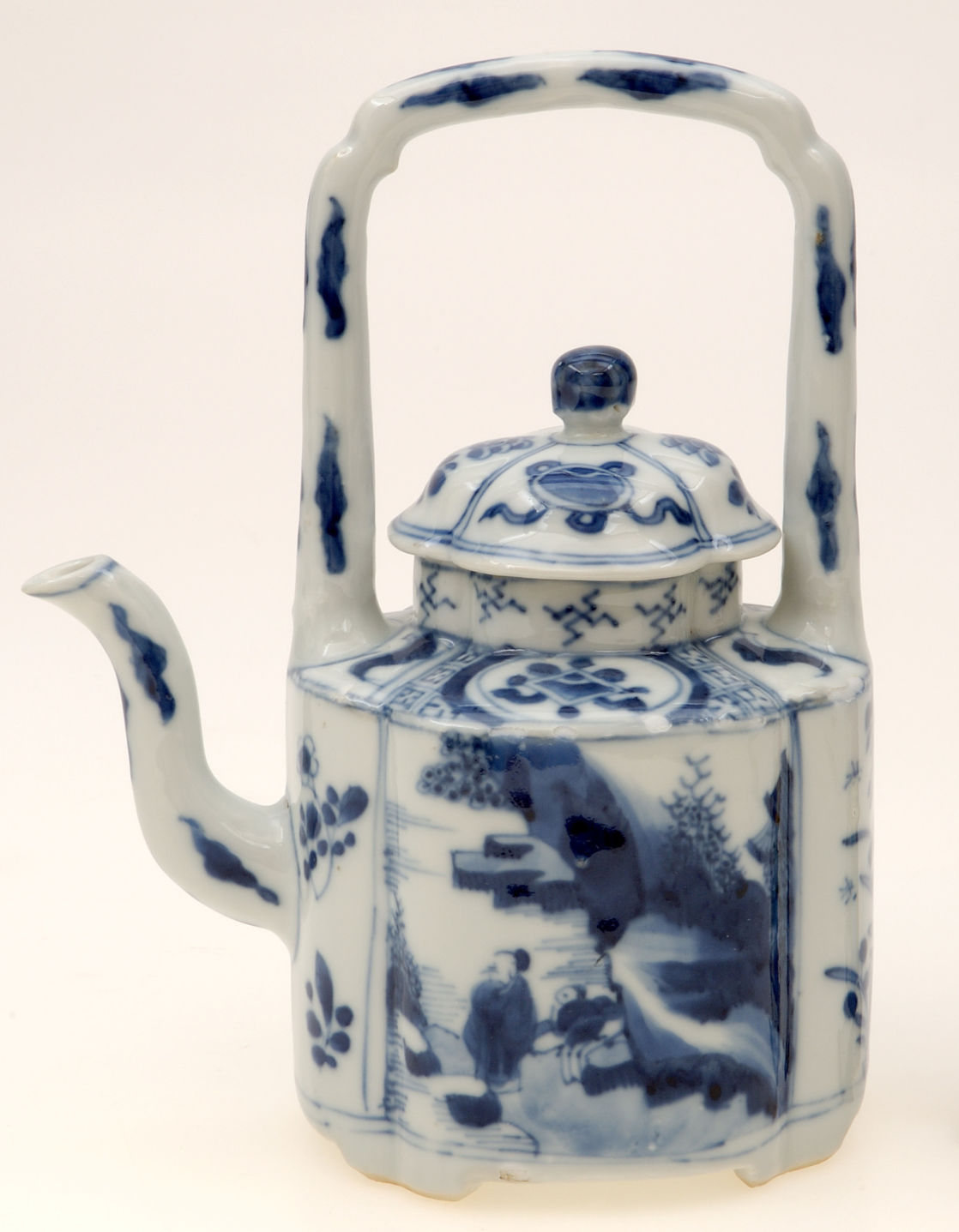
Teapot, China, 17th century (2nd half) Porcelain, blue underglaze decoration, width 13.5 cm, height 18 cm Photo: Angelo Lui
The Dutch soon imitated spherical Chinese teapots in earthenware, which were included in the Delftware range from 1660. Dutch potters working in Staffordshire in the late 17th century also took inspiration from Yixing, making ‘red Chinese porcelain’ teapots. In around 1706–7 the Meissen factory in Germany started producing ‘Böttger ware’, a compact, red stoneware, which approximated that of Yixing; and in 1710 the company succeeded in creating white porcelain.
Early 18th-century Meissen spherical porcelain teapots also imitated polychrome Chinese decorative designs, although Turkish motifs were also used. Animal and plant motifs were used widely at Meissen from c.1720. Inspired by Chinese antecedents, European ceramists also modelled spouts, handles or lid finials in plant or animal forms, including a rabbit sitting on a Hungarian teapot lid (Herend, c.1870).
EUROPEAN FORMS
In the late 18th century, European manufacturers distanced themselves from Chinese influences, introducing non-spherical teapot shapes. These included cylinders, cubes, rectangular prisms and pyramids. They also introduced more diversity in the shapes of added elements, including handles, spouts, lids and the finials used to lift them. By 1780–85 spherical and pear-shaped bodies, characteristic of Chinese teapots, were almost entirely supplanted, reflecting the European fashion for simple forms inspired by Classical art.
From the 1770s–1780s Josiah Wedgwood’s Etruria factory (founded in 1769) produced Jasperware, a form of stoneware either coloured throughout or covered with a coloured slip (‘dip’ or ‘dipped’).
The manufacture of teapots and tea services (in matching shapes bearing the same decorative design) contributed to the commercial success of English ceramics. Following its introduction by the Duchess of Bedford in the 1840s, taking afternoon tea became a fashionable pastime. The rest is history. As tea drinking democratised and spread through all levels of English society it became indelibly linked with the national character.
‘We drink tea to forget the noise of the world,’ wrote the Tang Dynasty scholar and tea master Lu Yu (733–804). The world in shutdown against coronavirus has been preternaturally quiet, however eventually the teapot, which Garth Clark (The Artful Teapot, 2001) described as ‘that spouted steaming, engine of hospitality’, will no doubt again catalyse everyday social intercourse, in its mute role perfected over the last 500 years.
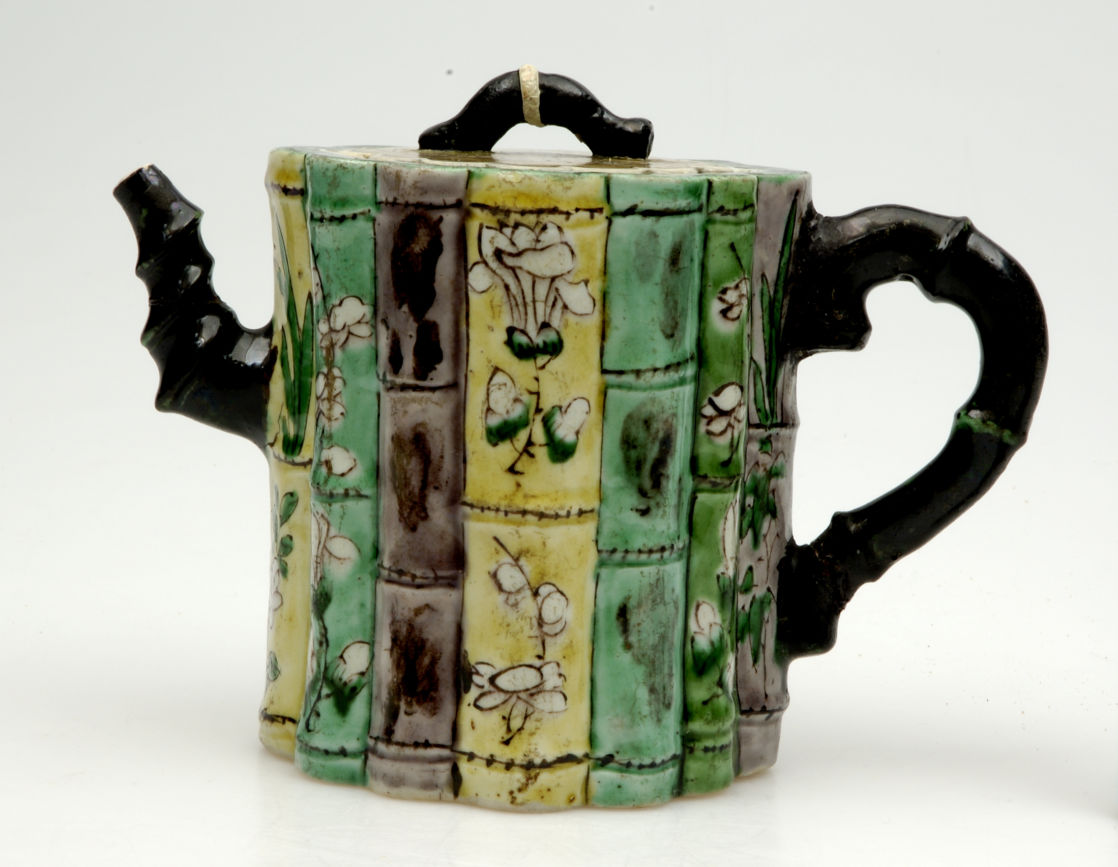
Teapot, Jingdezhen (China), 1672-1722 Porcelain, Famille verte enamel decoration, width 15.5 cm, height 12 cm Photo: Nathalie Sabato
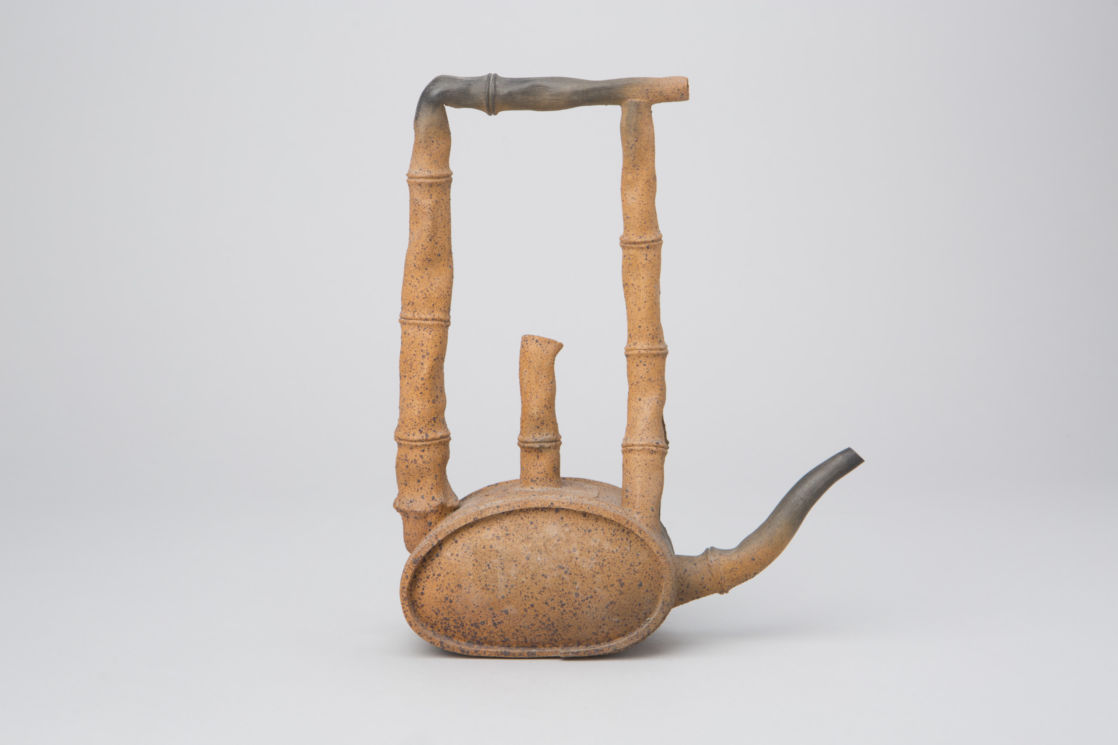
Teapot, Luo Xiaoping (Yixing, China), c.2002 Stoneware, length 19 cm, height 23.3 cm Photo: Nicolas Lieber
Gallivanting Teapots: Origins and Evolution of an Art of Living, Musée Ariana, Geneva, Switzerland, until 13 September 2020; institutions.ville-geneve.ch/en/ariana
This article is taken from the July/August 2020 issue of Ceramic Review. Find out more and subscribe below.